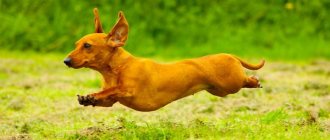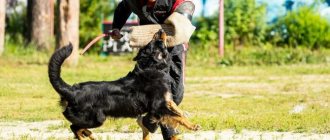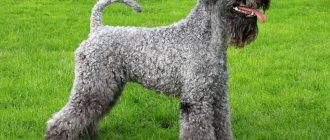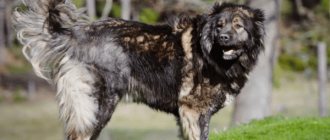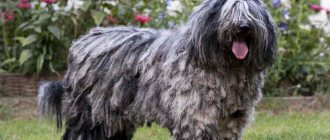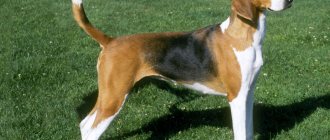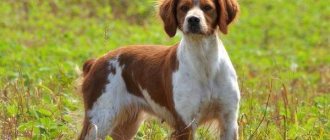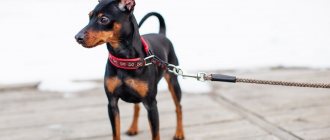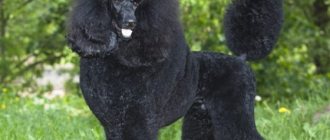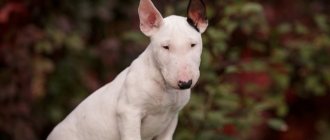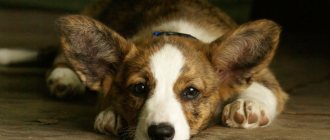Published: 3 months ago ⭐️⭐️⭐️⭐️⭐️
A description of the rabbit dachshund breed is usually of interest to those who decide to get this dog. The breed is suitable for experienced and novice dog breeders. Most owner reviews contain good characteristics.
Character 8/10 Health 7/10 Activity 7/10 Aggressiveness 6/10 Training 8/10 Care 5/10 Intelligence 7/10 Noisiness 6/10 Security qualities 6/10 Activity 5/10 Attitude towards children 10/10 Friendliness 9/10 Harmfulness 4/10
Brief history of origin
Rabbit dachshunds owe their origin to the Germans. It was in Germany that breeding work was carried out to breed a miniature dog with an unusual physique. The popularity of the dachshund was determined by the fact that representatives of the upper classes loved to spend time hunting, and they needed a dog as an assistant who could easily not only penetrate narrow holes, but also maneuver in them. However, some large dachshunds got stuck in underground passages.
The German breeder Engelman decided to take up the development of a smaller breed, and for these purposes he began breeding dachshunds with miniature pinschers. The idea was not successful: the puppies had the desired size, but they completely lacked the working qualities of a dachshund.
Later, in order to obtain the coveted sizes without sacrificing the skills of the hunter, they began to select the smallest puppies from the litter and breed them with each other in order to consolidate the mini-sizes in the breed. Breeding was complicated by the fact that dogs produced only 3–4 puppies per litter, and small ones were extremely rare among them.
Since 1905, under the leadership of Engelman, an association of dachshund lovers was created, and the breed began to gain popularity.
Description
The mini dog differs from its relatives in its elongated muscular body, very short legs, floppy ears, miniature size and typical muzzle. The standard requires the dog to have an elongated wedge-shaped head that is positioned high. The flat forehead has a pronounced occiput, and the transition of the muzzle to the skull is blurred. The bridge of the nose is distinguished by straight lines, it is narrow and long. The nose should be red-brown or black.
The lips are close-fitting, with characteristic pigmentation for black coats and brown for brown coats. The pet has a knife-like bite that closes tightly. Oval eyes are colored in shades from black-brown to red-brown. A merle-colored animal can have a “pearl” or blue color. The eyes are medium-sized, not too large, and have rims around the edges.
Interesting Facts
Interesting facts that not everyone knows:
- The rabbit dachshund is one of the oldest breeds.
- Several hundred years ago, the dachshund was called the “badger dog” because it was used to hunt badgers.
- Initially, all rabbit dachshunds were black. Now, thanks to long-term selection, there are 12 colors.
- Rabbit dachshunds can be found in many unpleasant caricatures: the breed became a victim of negative attitudes towards the rulers of Germany. And all because one of the emperors (William II) had 5 dachshunds.
- The breed is so intelligent that German scientists once claimed that the dachshund would soon be able to read and write. But they were never able to achieve such a result.
- The famous “Hot Dog” got its name in honor of the rabbit dachshund.
- In the UK, a dog was cloned for the first time, and it was a dachshund.
Hunting
More and more rabbit-like Dachshunds are being viewed as decorative, apartment pets...and this is a little unfair. With proper training and training, these dogs are capable of very successful work. By the way, the “flexibility” of the Dachshund does not depend on its size or origin. A puppy born from the mating of two show dogs can and will hunt. In the opposite case (buying a puppy “for a cushion” from working parents), some difficulties may arise with upbringing.
The Rabbit Dachshund was bred to work on hare and wild rabbit . Training starts at 4 months. The puppy must fully master the basic commands, after which the calibrations are transferred to the “training ground”. If the dog has to work underground, it is trained in the art of driving the animal out of the hole.
Rabbit Dachshunds are usually not trained to drive animals, although there is no justified reason for this! Most dogs are born unafraid of loud noises and will recognize a gun even if they have never seen one. There is a saying: “The dachshund is a breed created by hunting,” and its relevance can be confirmed by most established owners.
Breed description, standards and appearance
The breed is devoid of such qualities as cowardice and aggression. The dwarf rabbit dachshund is considered one of the best protectors among dogs, despite its modest size. This funny “rabbit” is ready to rush at a pack of larger animals, protecting its owner.
The rabbit dachshund differs from the standard dachshund in its size. It is smaller, narrower (chest circumference is up to 30 cm, versus 35 for the standard). Externally, a dog of this breed has a long body, disproportionately short legs to the body, an elongated narrow muzzle and huge ears.
The size of an adult rabbit dachshund can vary depending on gender, with boys usually being slightly larger.
General breed standards:
On a note. The breed has a stately posture, which gives confidence to the dog's appearance. Also, the muscles of the rabbit dachshund should be visible.
Color and coat type
Depending on the type of coat, there are 3 varieties of the breed:
The description of the breed indicates the color allowed by the standards:
For your information. In representatives of the rabbit dachshund breed, small spots in color are acceptable.
What is the difference from the breed standard?
There is confusion here regarding the name of one of the types of dachshunds - “standard”. The breed is divided into three types, each of which is included in the standard:
- standard – height from 20 to 27 centimeters and weight up to 9 kilograms;
- dwarf - from 14 to 21 centimeters, weighing from 4 to 5.5 kilograms;
- rabbit - no more than 15 centimeters, weighing around 3.5 kilograms.
Thus, the rabbit dachshund differs in size from the standard one, but this is not a deviation from the breed standard. This is the smallest dachshund of all.
Character and behavior
Russian scientist L. Sabonaev gave a very accurate description of the psychology of the breed. He wrote that this is a very smart, flexible dog that understands its owner at one glance. The Rabbit Dachshund becomes attached to its human and can be a bit clingy. She cannot stand loneliness and harsh treatment. The breed also has such qualities as pride, stubbornness and rancor.
The rabbit dachshund is more suitable for indoor use than spitz dogs, toy terriers and chihuahuas, as it will not bark for no reason. But she still knows how to bark and will use this skill as soon as she senses danger.
The breed is suitable for both large families with children and single people, becoming a reliable friend and protector. The dachshund is friendly towards small family members and is ready to join in the games! But you should immediately teach your child to carefully handle the animal: the dachshund should not be offended, it may growl at the child or take revenge with bad behavior.
Distinctive characteristics of the rabbit dachshund breed:
The owner of the dog should also have these characteristics. If you need a dog that will stay in the apartment for days, then it is better to give preference to another breed, since the rabbit dachshund will wither in such conditions.
Your pet should not be left alone or in the care of other people for a long time. The rabbit dachshund does not tolerate separation from its owner well and may become ill.
Currently, rabbit dachshunds are used less and less in hunting. The breed is chosen for apartment keeping, because it is quite compact. But the working qualities of a rabbit dachshund remain regardless of where they live: it will happily chase birds in the street and mice in the yard.
Hunting instincts prevent representatives of this breed from getting along with other domestic animals of the same or smaller sizes. At an early age, the rabbit dachshund can play with them, but in the future it will see cats or rodents as objects of hunting.
The rabbit dachshund is a good guardian of the owner’s property and life. She does not attack first and only shows aggression when absolutely necessary.
Representatives of the breed have developed intelligence and quickly remember commands.
Application
In modern conditions, the dwarf breed is used as indoor decorative dogs. As it is now fashionable to call it – a companion dog.
The dog is capable of bringing joy to all family members, although he is completely devoted only to his owner.
A faithful friend is ready to accompany loved ones even to the ends of the earth. He is tireless and can withstand physical stress even on the longest journeys.
Miniature dachshunds are good swimmers, so they handle well when fetching game from the water when hunting ducks.
Representatives of the breed are affectionate and attached to their owners, they love comfortable gatherings in the arms of their owners.
When the whole family gathers around the TV, the little dog is also ready to delicately keep company:
- She does not lose her mind from unusual things that suddenly begin to happen before her eyes.
- A dachshund male, unlike males of other breeds, will never run to the smell of a female dog in heat, guided only by instinct. Even at such a moment they are guided by reason.
- In terms of cleanliness, they are similar to cats: having accidentally fallen into a puddle, they try to get out of it on their tiptoes so as not to get too dirty.
- They are wary of strangers and animals, although around their family the dachshund is sociable, delicate and affectionate.
- The guard instinct is very well developed, but they will never attack first without reason.
- No matter how much a rabbit dachshund wants to go to the toilet, it will endure as long as necessary, but will never allow such embarrassment in the house.
- She will not beg near the table, but if she is ignored, she may be offended and decently leave for her place.
- Dogs love outdoor games, they are good companions and nannies for children, and on the street they will protect a child no worse than a guard dog.
- To a stranger outside the door, the menacing voice of a dachshund may seem like the barking of a large and dangerous dog.
Rabbit dachshunds are passable swimmers
How to choose the right puppy
You should not take the puppy away from its mother before it reaches two months of age, otherwise the dog may grow up fearful, nervous and have difficulty making contact with people. A two-month-old baby can already eat any food, and by this time responsible breeders will have already given the puppy his first vaccination and taught him to use a diaper when needed.
When choosing a dwarf rabbit dachshund dog, special attention should be paid to its health. It is very difficult to treat acquired or hereditary diseases. First of all, inspect the place where the dogs are kept, their diet; a conscientious breeder will not refuse this. You should refuse the deal if the mother of the puppies and her offspring are kept in a dark, cold and damp room, and their diet consists of cereals without meat and vitamin supplements or dry cheap food.
Even after feeding, puppies' bellies should not increase in size. Look at how the baby moves; he should have no problems with coordination (not to be confused with clumsiness).
During the external examination, you should pay attention to:
- eyes – do not water, the puppy does not blink often;
- coat – smooth, shiny, even;
- the back is flat, without humps;
- tail - without creases.
Note the presence of a small scar near the toes on the hind legs - this is a mark from the removal of the fifth toe. The operation must be carried out on the second day of the puppies’ life.
It’s worth watching the kids play and choosing the puppy that best suits its character. Some will be more active, others will be affectionate and modest.
Important. If you plan to participate in exhibitions in the future, it is recommended to show the puppy to an experienced dog handler to evaluate the exterior.
When the puppy is six months old, the owner makes a pedigree for his dog. The breeder must only hand over the puppy's card and veterinary passport. If there is no card, there must be a brand on the puppy's belly or ear; based on it, you can get a pedigree without a puppy card.
It is important to draw up a purchase and sale agreement; it will protect against unscrupulous breeders if the dog suddenly turns out to be outbred or has a hereditary disease.
Recommendation. You should purchase a puppy of this breed only from trusted breeders. You can find a nursery with a good reputation in Moscow and other large cities of Russia.
Puppies
Like all children, rabbit dachshund puppies are very mobile and active. They take time, you need to play with them a lot, otherwise all the objects that the puppy comes across will be used. For example, a dog may chew on shoes.
Before you bring your puppy home, be prepared. Buy a tray and/or diapers (at first, until vaccination is completed, you cannot take the animal for a walk), toys, and arrange a sleeping place.
Males need to be taught to go to the toilet not only in the litter box, but also outside, always on a leash. When a male representative of the breed turns one year old, he will begin to mark his territory, and there will be an unpleasant smell in the house. Walking will solve this problem. As for the leash, this is a necessity: in the future, the dog, sensing that another dog is in heat, may run away and get lost.
Price of a rabbit dachshund
- The cost of a purebred dachshund rabbit puppy, with all documents and confirmed pedigree, ranges from 30 to 40 thousand rubles.
- If you do not plan to take your dog to exhibitions and competitions, you can find cheaper options. Puppies with deviations from the standard and disqualifying signs seriously lose value.
- For several thousand you can pick up a puppy, but he will not have documents and vaccinations, and there will be no guarantee that this is a rabbit dachshund and not an unknown crossbreed.
Care and maintenance
With proper care, the lifespan of a rabbit dachshund ranges from 12 to 17 years. This breed is not picky and does not require much effort to maintain. But there are still rules that a loving owner must follow.
The right diet
A dog's health largely depends on what it eats. You need to decide on the diet before the puppy arrives in the house so that he gets used to his food. Nutrition should be complete, balanced, nutritious, rich in vitamins.
When choosing ready-made food, you should give preference only to premium products: they contain a lot of meat ingredients, vitamins and microelements. Cheap food can cause your dog to develop diseases and deteriorate its external and working qualities. Do not forget that when eating dry food, the dog must drink a lot; a lack of fluid will cause kidney disease, dehydration, constipation and other diseases.
If the animal eats premium food, there is no need to give the pet additional vitamins, since the food already contains the amount of vitamins and minerals necessary for normal development.
When choosing natural food, you should remember that you should not give your dog expired, sour, or low-quality products. And food from the table of people is completely contraindicated for dachshunds.
List of permitted products:
- lean boneless meat – 50–60% of the daily diet daily;
- low-fat sea fish (boiled only, without bones) – 1–2 times a week;
- boiled eggs – once a week;
- cereals (buckwheat, barley, millet, oatmeal) - daily in the form of porridge;
- pasta – rarely;
- vegetables and fruits (in any form) - every day;
- fermented milk products – 1–2 times a week;
- bread - rarely.
You cannot add salt and spices to food, or serve hot porridge. It is not recommended to serve meat raw; it must either be boiled or scalded with boiling water.
Prohibited products:
- everything salted and smoked, fried;
- peas (causes bloating and gas);
- pearl barley (empty product);
- pork;
- sweets and confectionery;
- sausages;
- bones (contrary to the general belief that dogs should be given bones, they are prohibited: fragments can injure the gastric mucosa and oral cavity);
- baking
Additionally, it is recommended to give your pet vitamin and mineral complexes.
Meals should be given twice a day; puppies are accustomed to it from six months to 8 months (more often at a younger age, up to 5-6 times a day). You should not give food before a walk or physical activity. After eating, the dachshund needs to rest.
Walking and exercise
The rabbit dog, like all dachshunds, is prone to obesity, so it simply needs long walks and physical activity.
The right approach:
- games in the park;
- walks twice a day for at least 1 km at a time;
- You can’t scold a dog for chasing squirrels and frogs, it’s in their blood;
- going out into nature;
- active games not only on the street, but also at home.
Important. The smooth-haired rabbit dachshund does not tolerate cold and frost. Buy warm overalls for winter, and a cute raincoat for walks in the rain.
Training and education
This breed is distinguished by its intelligence. Even without commands, rabbit dachshunds understand what can and cannot be done. But it’s still worth teaching your pet basic commands.
You need to teach your dog to respond to his name. It is important to call your pet only by its nickname, avoiding diminutive variants. When the dog understands that he is being addressed, you can change his nickname.
The same command should not have multiple options:
- “take your place” is not replaced with “go away”, “leave me alone”, etc.;
- you should choose one of the wordings - “fu” or “impossible”, do not use both, otherwise the dog may get confused.
A rabbit dog needs to know its place, so it is important to train it to sleep only in its territory.
On a note. If you need your rabbit dachshund to follow complex commands, it is better to contact an experienced dog handler.
Care and hygiene
Not only the appearance of the dog, but also its health depends on hygiene and care.
Basic Rules:
Love and affection are a mandatory manifestation of care and care. If the owner shows his love, the pet will be happy.
Psychology
The famous Russian scientist L. Sabaneev described the psychology of the dachshund very accurately:
“They are too smart, easy-going, understand their master at a glance and are very attached to him, sometimes annoying.
The rabbit dachshund requires an affectionate attitude towards itself; strict treatment of them is unacceptable - there are notes of pride in their character, they are stubborn, and sometimes vindictive and even touchy.
If you want to please your pet, we recommend reading the article on how to make toys for your dog with your own hands:
A dog of this breed is more suitable for a home than many other breeds - their excellent hearing never fails, so they never make noise for no reason, like terriers and spitz barking for any reason.”
The rabbit dachshund is extremely balanced and calm
Vaccinations and susceptibility to disease
Vaccination of an animal is a mandatory procedure, even if the dog lives without a walk. The owner himself can bring viruses on his clothes, and the pet will be in danger if it is not vaccinated.
Standard vaccination schedule:
Of the diseases, rabbit dachshunds are most prone to spinal dysplasia; joint problems are also often observed. Jumping even from a small height can cause harm to the dog.
In addition, the breed is prone to ear diseases and obesity, all of which can be prevented with regular hygiene procedures and proper nutrition.
Diseases and life expectancy
On average, dachshunds live for about 13 years. Proper care and maintenance will help your pet live longer.
The list of diseases to which the breed is prone is quite large:
- swimmer's syndrome;
- problems with the spine;
- joint problems;
- dental diseases;
- skin diseases;
- eye diseases;
- diabetes;
- epilepsy.
Many diseases are associated with obesity. Dachshunds are susceptible to numerous injuries.
Pros and cons of the breed
At first glance, it may seem that the rabbit dachshund is an ideal dog. But, like any living creature, it has its drawbacks.
AdvantagesDisadvantages
| Attractive appearance | It is important to monitor your diet and give your dog exercise, as the breed has a tendency to become obese. |
| High security, guard and hunting qualities | Long walks and active games are required |
| They treat children well and are friendly with each family member. | React poorly to other pets |
| Not picky about food | They do not tolerate bad attitudes or rudeness. |
| Smart, easy to train | |
| High life expectancy |
Dachshund owners always stand out from the crowd thanks to the exquisite appearance of their pets. At home, a rabbit dachshund is a devoted friend who will not let you fall into depression, will cheer you up, and, if necessary, will sit quietly next to you. The compactness of representatives of this breed allows you to keep the animal in a small apartment, and its quiet disposition will not disturb the neighbors.
